Unit 10 I'd like some noodles Period 1 Section A(1a-2d)课件+嵌入音频(共37张PPT)
文档属性
| 名称 | Unit 10 I'd like some noodles Period 1 Section A(1a-2d)课件+嵌入音频(共37张PPT) | 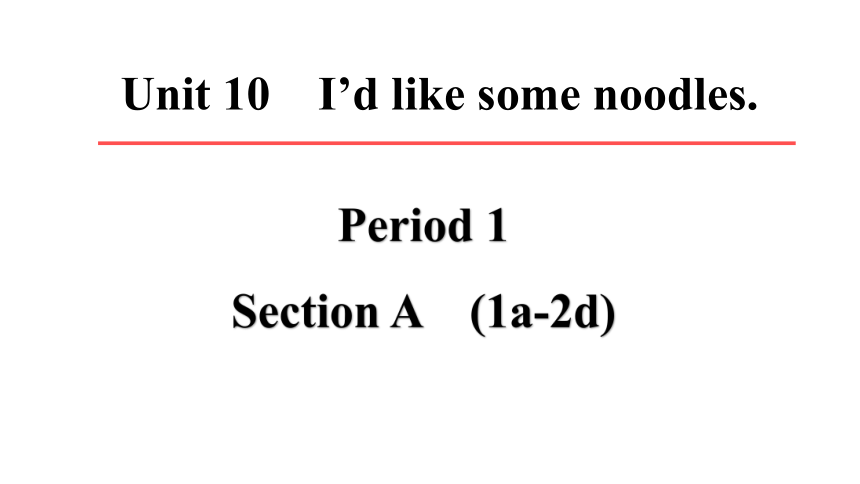 | |
| 格式 | pptx | ||
| 文件大小 | 18.5MB | ||
| 资源类型 | 教案 | ||
| 版本资源 | 人教新目标(Go for it)版 | ||
| 科目 | 英语 | ||
| 更新时间 | 2023-12-17 09:47:44 | ||
图片预览

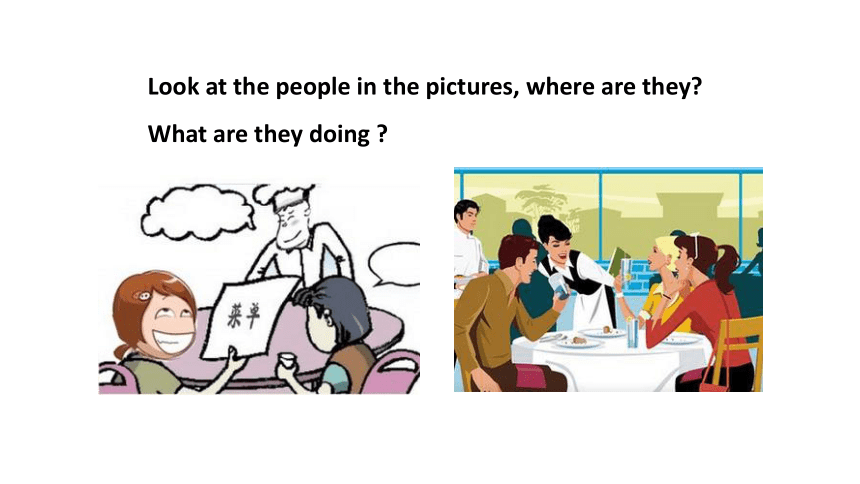
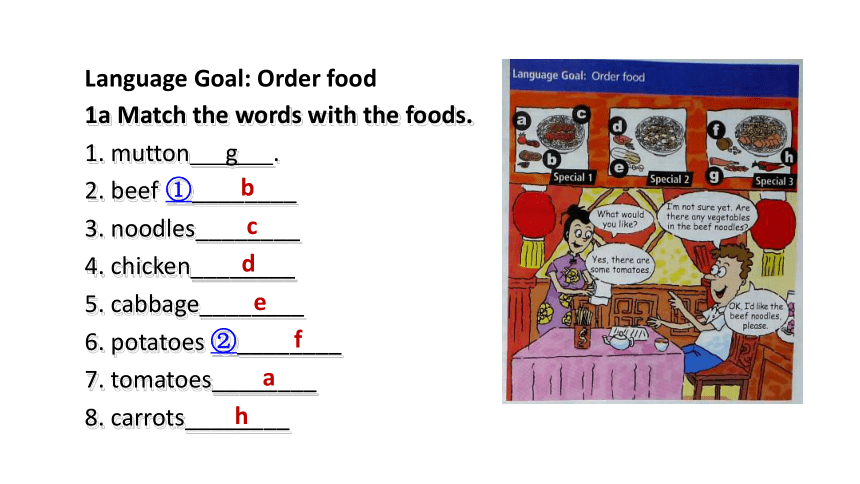

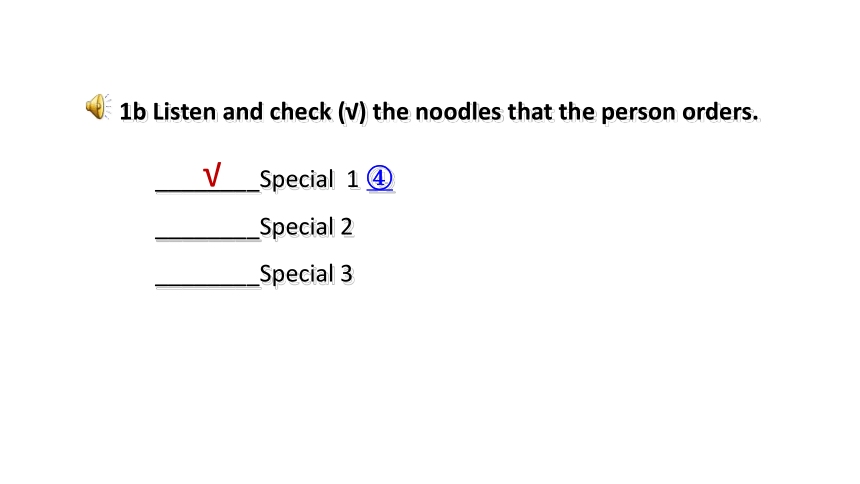
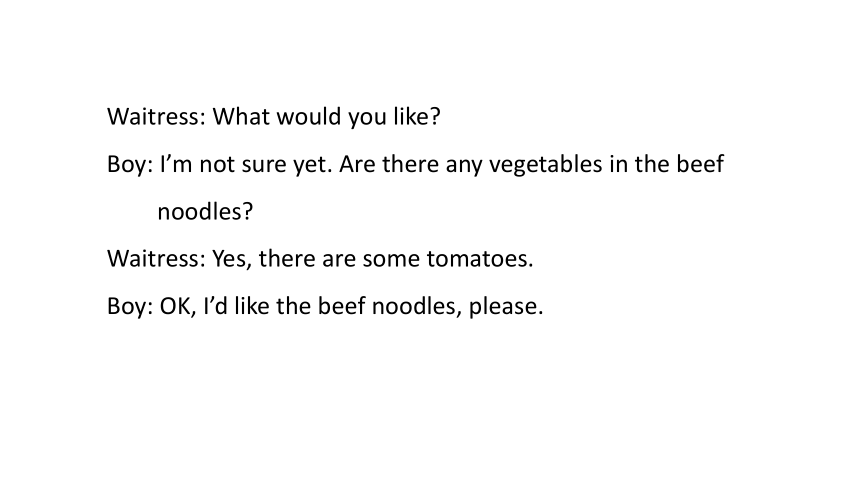

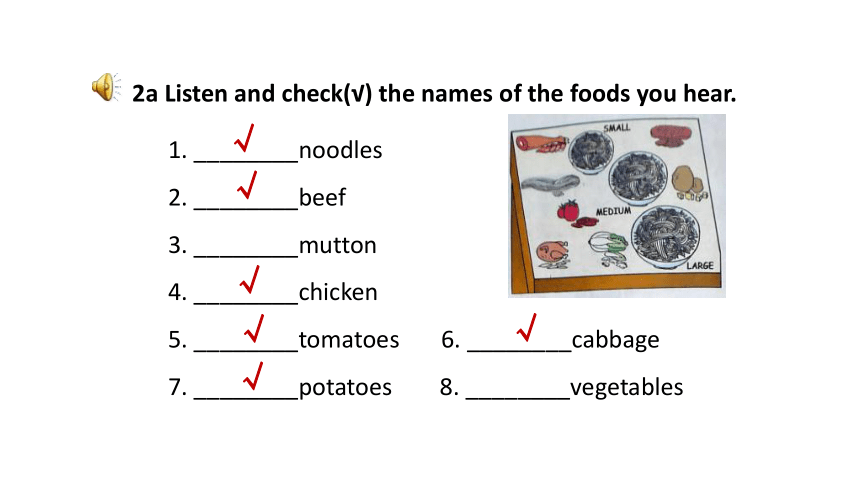

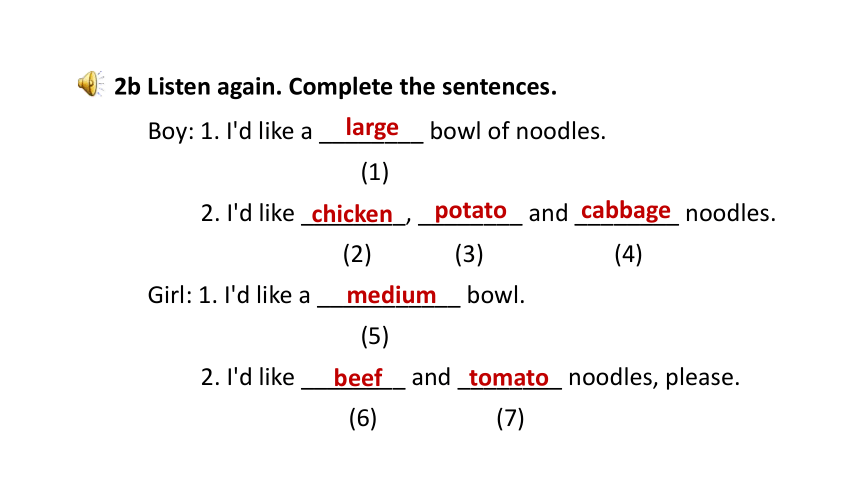

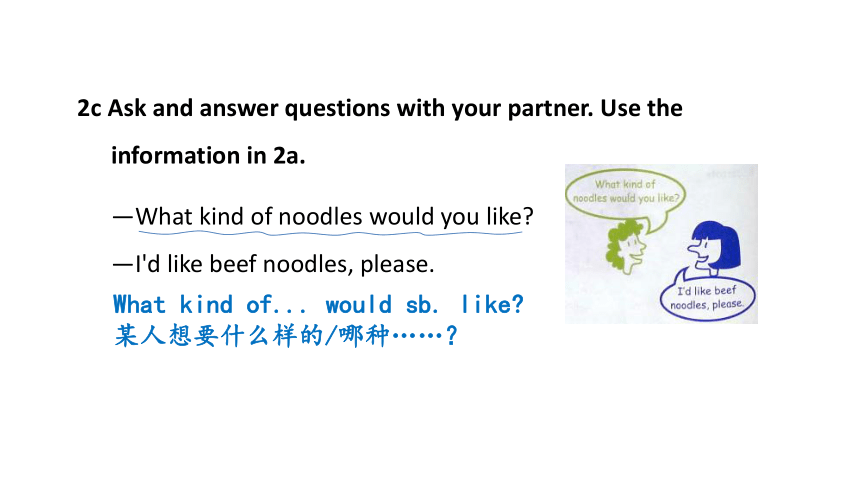
文档简介
(共37张PPT)
Period 1
Section A (1a-2d)
Unit 10 I’d like some noodles.
Look at the people in the pictures, where are they
What are they doing
1a Match the words with the foods.
1. mutton g .
2. beef ①________
3. noodles________
4. chicken________
5. cabbage________
6. potatoes ②________
7. tomatoes________
8. carrots________
b
c
d
e
f
a
h
Language Goal: Order food
—What would you like
—I'm not sure yet. ③ Are there any vegetables in the beef noodles
—Yes, there are some tomatoes.
—OK, I‘d like the beef noodles, please.
1b Listen and check (√) the noodles that the person orders.
________Special 1 ④
________Special 2
________Special 3
√
Waitress: What would you like
Boy: I’m not sure yet. Are there any vegetables in the beef noodles
Waitress: Yes, there are some tomatoes.
Boy: OK, I’d like the beef noodles, please.
1c Practice the conversation in 1a with your partner. Then make your own conversations.
2a Listen and check(√) the names of the foods you hear.
1. ________noodles
2. ________beef
3. ________mutton
4. ________chicken
5. ________tomatoes 6. ________cabbage
7. ________potatoes 8. ________vegetables
√
√
√
√
√
√
Waiter: What size would you like
Boy: I’d like a large bowl of noodles.
Waiter: And what kind of noodles would you like
Boy: I’d like chicken, potato and cabbage noodles.
Waiter: And how about you
Girl: I’d like a medium bowl.
Waiter: What kind would you like
Girl: I’d like beef and tomato noodles, please.
2b Listen again. Complete the sentences.
Boy: 1. I'd like a ________ bowl of noodles.
(1)
2. I'd like ________, ________ and ________ noodles.
(2) (3) (4)
Girl: 1. I'd like a ___________ bowl.
(5)
2. I'd like ________ and ________ noodles, please.
(6) (7)
large
chicken
potato
cabbage
medium
beef
tomato
Waiter: What size would you like
Boy: I’d like a large bowl of noodles.
Waiter: And what kind of noodles would you like
Boy: I’d like chicken, potato and cabbage noodles.
Waiter: And how about you
Girl: I’d like a medium bowl.
Waiter: What kind would you like
Girl: I’d like beef and tomato noodles, please.
2c Ask and answer questions with your partner. Use the information in 2a.
—What kind of noodles would you like
—I'd like beef noodles, please.
What kind of... would sb. like
某人想要什么样的/哪种……?
2d Role -play the conversation.
Waitress: Good afternoon. May I take your order ⑤
Sally: Yes. Are there any vegetables in the beef soup
Waitress: Yes. There are some tomatoes.
Sally: OK. We'd like one bowl of beef soup. ⑥
Waitress: Sure. What size would you like ⑦
Sally: Large, please.
Tom: We'd also like gongbao chicken and some mapo tofu with rice.
Waitress: OK. One large bowl of beef soup, one gongbao chicken, and one mapo tofu with rice. Tom Yes, that's right.
学习之余可通过书籍、互联网等了解中国传统美食的特征、由来等。学会其英文表达,宣传中国传统美食。
①beef
beef/bi f/ n. 牛肉
e. g. Would you like beef or mutton
你想要牛肉还是羊肉
考点1
不可数名词
表示肉类的名词是不可数名词。如:
fish 鱼肉
chicken 鸡肉
mutton 羊肉
beef 牛肉
考题1: [河池] —Lisa, could you help me buy some _____ on your way home
—OK, Mom.
A. egg B. beef C. banana D. potato
B
返回
②potato
potato/p te t / n. 土豆; 马铃薯
e. g. He’d like some potatoes. 他想要一些土豆。
拓展:以字母-o 结尾的名词:有生命的词,复数形式是在词尾加-es;无生命的词,复数形式是在词尾加-s。
e.g. tomato — tomatoes 西红柿 hero — heroes 英雄
photo — photos 照片 radio — radios 收音机
考点2
复数是potatoes
常见的以-o 结尾的可数名词变复数加-es的词:
土豆(potato) 和西红柿(tomato) 敬英雄(hero)。
考题2: [云南] We’re going to make vegetable salad. How many _______________ (tomato) do we need
返回
tomatoes
③I’m not sure yet.
yet /jet/ adv. (常用于否定句或疑问句) 还;仍然
谈论尚未发生但可能发生的事。具体用法如下:
考点3
用法 示例
用在否定句中, 意为“还; 仍然”。 The reason isn’t clear yet. 原因尚不清楚。
用在疑问句中, 意为“已经”。 Is everything ready yet
一切都已经准备就绪了吗?
考向
辨析: yet、already和still
yet “还;仍然”,指尚未发生但可能发生的事;
already “已经”,强调动作已经开始发生或某种情况已经存在;
still “还,仍然”,强调原有状态没有改变。
一语辨异:It's already 6:00 p.m. Jack isn't back yet. He is still at school.
已经是下午6点了。杰克还没回来,他还在学校。
拓展: yet 还可用作连词,用于肯定句中,意为“然而;但是”。
e.g. He has a good job. It is strange yet true.
他有份好工作。这虽然奇怪却是真实的。
考题3: —What food would you like to eat
—Oh, I’m not sure _______.
A. yet B. too C. also D. only
返回
A
④Special 1
special/spe l/ n. 特色菜; 特价品
e.g. What are the specials in your restaurant
你们餐厅有什么特色菜?
考点4
可数名词
special 作形容词时的常见搭配:
① a special day 一个特别的日子
② a special train 专列
③ special education 特殊教育
拓展:(1) special 还可作形容词, 意为“特别的, 特殊的; 专用的”。
e.g. Is there anything special in our school
我们学校有什么特别的地方吗?
You can go to a special hospital. 你可以去专科医院。
(2) special 的副词形式是specially, 意为“特别; 特意; 专门地”。
e.g. We come specially to learn from you.
我们是特地来向您学习的。
返回
考题4:[新疆改编] There is no other food that is as s as nang in Xinjiang.
【点拨】由no other food与nang 及首字母s 可知,句意应为“在新疆,没有其他的食物和馕一样特殊”。
pecial
⑤May I take your order
May I take your order 您可以点餐了吗?
本句是点餐常用语, 用于服务员询问客人是否可以点餐了。回答时一般先说“Yes.”,然后说“I’d like...”说明点什么餐。
e.g. —May I take your order 您现在点餐吗?
—Yes. I’d like one bowl of mutton noodles.
是的。我想要一碗羊肉面。
考点5
考向
其他点餐的常用语:
Are you ready to order 您可以点餐了吗?
What would you like 你想吃/喝些什么?
Can I help you
= What can I do for you 您想要点什么?
Here’s the menu. 给您菜单。
考题5: [昆明] —________
—Yes. I’d like a bowl of beef noodles.
A. Can you help me B. How was your day
C. May I take your order D. What would you like to drink
【点拨】用情景交际法。由答语可知,问句应是一般疑问句且与点餐有关,故用May I take your order。
C
order / (r) d (r) / n. &v. 点菜; 命令
作名词,意为“点菜”,take one’s order “点菜”。
e.g. This is your order. 这是你点的菜。
You can take your order online. 你可以在线点菜。
考点6
考向1
小贴士:in order to 为了
e.g. We should be honest in order to teach honesty to our children. 我们应该诚实,以便教我们的孩子诚实。
作名词, 意为“命令;顺序”, keep in good order “井然有序”。
e.g. He found everything in good order. 他发现一切井然有序。
order 作动词时还可意为“点菜;命令; 订购”。order sb. to do sth. 命令某人做某事。
e.g. He is ordering his son to do homework.
他在命令儿子去做作业。
I’d like to order some noodles. 我想点些面条。
I want to order a book on the Internet.
我想在网上订购一本书。
考向2
考向3
考题6: [日照] Kate’s room is in good o and everything is in its proper place.
返回
rder
⑥We’d like one bowl of beef soup.
one bowl of... 一碗
one bowl of... 后跟可数名词复数或不可数名词, 强调容量而不是数量;表示复数概念时, 直接把bowl 变为复数形式即可。
e.g. Mary only eats one bowl of porridge for breakfast.
玛丽早餐只吃一碗粥。
There are two bowls of rice on the table.
桌子上有两碗米饭。
考点7
考向
= a bowl of
“不定冠词/基数词+量词+ of +不可数名词”结构常用来表示不可数名词的数量。
e.g. a bottle of water 一瓶水
two bags of rice 两袋大米
a glass of milk 一杯牛奶
拓展:“基数词+ 量词+ of + 名词”作主语时,谓语动词与量词在数上保持一致。
e.g. A box of books is OK. 一箱子书就可以了。
There are two bags of rice. 有两袋米。
返回
⑦What size would you like
What size... ……多大尺寸/ 尺码?
此句型是用来询问物体的大小、尺寸的句型, 其中size 用作名词, 意为“大小;尺码”。
考点8
在表达大、中、小号时常用以下词:
L=large 大号的 M=medium 中号的
S=small 小号的
考向
e. g. —What size shoes does your father wear
你爸爸穿多大号的鞋?
—He wears size 41.
他穿41 号的鞋。
—What size bowl of rice would you like
你想要多大碗的米饭?
—A large bowl, please.
请来一大碗。
返回
本节课主要练习了听力, 学习了饭店点餐的句型What would you like , I’m not sure yet. , What kind of noodles would you like , May I take your order 及知识点mutton, special, beef noodles, one bowl of, what size等的用法。
Period 1
Section A (1a-2d)
Unit 10 I’d like some noodles.
Look at the people in the pictures, where are they
What are they doing
1a Match the words with the foods.
1. mutton g .
2. beef ①________
3. noodles________
4. chicken________
5. cabbage________
6. potatoes ②________
7. tomatoes________
8. carrots________
b
c
d
e
f
a
h
Language Goal: Order food
—What would you like
—I'm not sure yet. ③ Are there any vegetables in the beef noodles
—Yes, there are some tomatoes.
—OK, I‘d like the beef noodles, please.
1b Listen and check (√) the noodles that the person orders.
________Special 1 ④
________Special 2
________Special 3
√
Waitress: What would you like
Boy: I’m not sure yet. Are there any vegetables in the beef noodles
Waitress: Yes, there are some tomatoes.
Boy: OK, I’d like the beef noodles, please.
1c Practice the conversation in 1a with your partner. Then make your own conversations.
2a Listen and check(√) the names of the foods you hear.
1. ________noodles
2. ________beef
3. ________mutton
4. ________chicken
5. ________tomatoes 6. ________cabbage
7. ________potatoes 8. ________vegetables
√
√
√
√
√
√
Waiter: What size would you like
Boy: I’d like a large bowl of noodles.
Waiter: And what kind of noodles would you like
Boy: I’d like chicken, potato and cabbage noodles.
Waiter: And how about you
Girl: I’d like a medium bowl.
Waiter: What kind would you like
Girl: I’d like beef and tomato noodles, please.
2b Listen again. Complete the sentences.
Boy: 1. I'd like a ________ bowl of noodles.
(1)
2. I'd like ________, ________ and ________ noodles.
(2) (3) (4)
Girl: 1. I'd like a ___________ bowl.
(5)
2. I'd like ________ and ________ noodles, please.
(6) (7)
large
chicken
potato
cabbage
medium
beef
tomato
Waiter: What size would you like
Boy: I’d like a large bowl of noodles.
Waiter: And what kind of noodles would you like
Boy: I’d like chicken, potato and cabbage noodles.
Waiter: And how about you
Girl: I’d like a medium bowl.
Waiter: What kind would you like
Girl: I’d like beef and tomato noodles, please.
2c Ask and answer questions with your partner. Use the information in 2a.
—What kind of noodles would you like
—I'd like beef noodles, please.
What kind of... would sb. like
某人想要什么样的/哪种……?
2d Role -play the conversation.
Waitress: Good afternoon. May I take your order ⑤
Sally: Yes. Are there any vegetables in the beef soup
Waitress: Yes. There are some tomatoes.
Sally: OK. We'd like one bowl of beef soup. ⑥
Waitress: Sure. What size would you like ⑦
Sally: Large, please.
Tom: We'd also like gongbao chicken and some mapo tofu with rice.
Waitress: OK. One large bowl of beef soup, one gongbao chicken, and one mapo tofu with rice. Tom Yes, that's right.
学习之余可通过书籍、互联网等了解中国传统美食的特征、由来等。学会其英文表达,宣传中国传统美食。
①beef
beef/bi f/ n. 牛肉
e. g. Would you like beef or mutton
你想要牛肉还是羊肉
考点1
不可数名词
表示肉类的名词是不可数名词。如:
fish 鱼肉
chicken 鸡肉
mutton 羊肉
beef 牛肉
考题1: [河池] —Lisa, could you help me buy some _____ on your way home
—OK, Mom.
A. egg B. beef C. banana D. potato
B
返回
②potato
potato/p te t / n. 土豆; 马铃薯
e. g. He’d like some potatoes. 他想要一些土豆。
拓展:以字母-o 结尾的名词:有生命的词,复数形式是在词尾加-es;无生命的词,复数形式是在词尾加-s。
e.g. tomato — tomatoes 西红柿 hero — heroes 英雄
photo — photos 照片 radio — radios 收音机
考点2
复数是potatoes
常见的以-o 结尾的可数名词变复数加-es的词:
土豆(potato) 和西红柿(tomato) 敬英雄(hero)。
考题2: [云南] We’re going to make vegetable salad. How many _______________ (tomato) do we need
返回
tomatoes
③I’m not sure yet.
yet /jet/ adv. (常用于否定句或疑问句) 还;仍然
谈论尚未发生但可能发生的事。具体用法如下:
考点3
用法 示例
用在否定句中, 意为“还; 仍然”。 The reason isn’t clear yet. 原因尚不清楚。
用在疑问句中, 意为“已经”。 Is everything ready yet
一切都已经准备就绪了吗?
考向
辨析: yet、already和still
yet “还;仍然”,指尚未发生但可能发生的事;
already “已经”,强调动作已经开始发生或某种情况已经存在;
still “还,仍然”,强调原有状态没有改变。
一语辨异:It's already 6:00 p.m. Jack isn't back yet. He is still at school.
已经是下午6点了。杰克还没回来,他还在学校。
拓展: yet 还可用作连词,用于肯定句中,意为“然而;但是”。
e.g. He has a good job. It is strange yet true.
他有份好工作。这虽然奇怪却是真实的。
考题3: —What food would you like to eat
—Oh, I’m not sure _______.
A. yet B. too C. also D. only
返回
A
④Special 1
special/spe l/ n. 特色菜; 特价品
e.g. What are the specials in your restaurant
你们餐厅有什么特色菜?
考点4
可数名词
special 作形容词时的常见搭配:
① a special day 一个特别的日子
② a special train 专列
③ special education 特殊教育
拓展:(1) special 还可作形容词, 意为“特别的, 特殊的; 专用的”。
e.g. Is there anything special in our school
我们学校有什么特别的地方吗?
You can go to a special hospital. 你可以去专科医院。
(2) special 的副词形式是specially, 意为“特别; 特意; 专门地”。
e.g. We come specially to learn from you.
我们是特地来向您学习的。
返回
考题4:[新疆改编] There is no other food that is as s as nang in Xinjiang.
【点拨】由no other food与nang 及首字母s 可知,句意应为“在新疆,没有其他的食物和馕一样特殊”。
pecial
⑤May I take your order
May I take your order 您可以点餐了吗?
本句是点餐常用语, 用于服务员询问客人是否可以点餐了。回答时一般先说“Yes.”,然后说“I’d like...”说明点什么餐。
e.g. —May I take your order 您现在点餐吗?
—Yes. I’d like one bowl of mutton noodles.
是的。我想要一碗羊肉面。
考点5
考向
其他点餐的常用语:
Are you ready to order 您可以点餐了吗?
What would you like 你想吃/喝些什么?
Can I help you
= What can I do for you 您想要点什么?
Here’s the menu. 给您菜单。
考题5: [昆明] —________
—Yes. I’d like a bowl of beef noodles.
A. Can you help me B. How was your day
C. May I take your order D. What would you like to drink
【点拨】用情景交际法。由答语可知,问句应是一般疑问句且与点餐有关,故用May I take your order。
C
order / (r) d (r) / n. &v. 点菜; 命令
作名词,意为“点菜”,take one’s order “点菜”。
e.g. This is your order. 这是你点的菜。
You can take your order online. 你可以在线点菜。
考点6
考向1
小贴士:in order to 为了
e.g. We should be honest in order to teach honesty to our children. 我们应该诚实,以便教我们的孩子诚实。
作名词, 意为“命令;顺序”, keep in good order “井然有序”。
e.g. He found everything in good order. 他发现一切井然有序。
order 作动词时还可意为“点菜;命令; 订购”。order sb. to do sth. 命令某人做某事。
e.g. He is ordering his son to do homework.
他在命令儿子去做作业。
I’d like to order some noodles. 我想点些面条。
I want to order a book on the Internet.
我想在网上订购一本书。
考向2
考向3
考题6: [日照] Kate’s room is in good o and everything is in its proper place.
返回
rder
⑥We’d like one bowl of beef soup.
one bowl of... 一碗
one bowl of... 后跟可数名词复数或不可数名词, 强调容量而不是数量;表示复数概念时, 直接把bowl 变为复数形式即可。
e.g. Mary only eats one bowl of porridge for breakfast.
玛丽早餐只吃一碗粥。
There are two bowls of rice on the table.
桌子上有两碗米饭。
考点7
考向
= a bowl of
“不定冠词/基数词+量词+ of +不可数名词”结构常用来表示不可数名词的数量。
e.g. a bottle of water 一瓶水
two bags of rice 两袋大米
a glass of milk 一杯牛奶
拓展:“基数词+ 量词+ of + 名词”作主语时,谓语动词与量词在数上保持一致。
e.g. A box of books is OK. 一箱子书就可以了。
There are two bags of rice. 有两袋米。
返回
⑦What size would you like
What size... ……多大尺寸/ 尺码?
此句型是用来询问物体的大小、尺寸的句型, 其中size 用作名词, 意为“大小;尺码”。
考点8
在表达大、中、小号时常用以下词:
L=large 大号的 M=medium 中号的
S=small 小号的
考向
e. g. —What size shoes does your father wear
你爸爸穿多大号的鞋?
—He wears size 41.
他穿41 号的鞋。
—What size bowl of rice would you like
你想要多大碗的米饭?
—A large bowl, please.
请来一大碗。
返回
本节课主要练习了听力, 学习了饭店点餐的句型What would you like , I’m not sure yet. , What kind of noodles would you like , May I take your order 及知识点mutton, special, beef noodles, one bowl of, what size等的用法。
同课章节目录
- Unit 1 Can you play the guitar?
- Section A
- Section B
- Unit 2 What time do you go to school?
- Section A
- Section B
- Unit 3 How do you get to school?
- Section A
- Section B
- Unit 4 Don't eat in class.
- Section A
- Section B
- Unit 5 Why do you like pandas?
- Section A
- Section B
- Unit 6 I'm watching TV.
- Section A
- Section B
- Review of Units 1-6
- Unit 7 It's raining!
- Section A
- Section B
- Unit 8 Is there a post office near here?
- Section A
- Section B
- Unit 9 What does he look like?
- Section A
- Section B
- Unit 10 I'd like some noodles.
- Section A
- Section B
- Unit 11 How was your school trip?
- Section A
- Section B
- Unit 12 What did you do last weekend?
- Section A
- Section B
